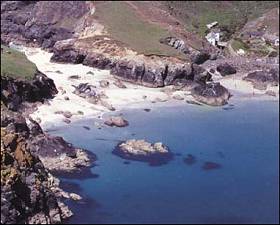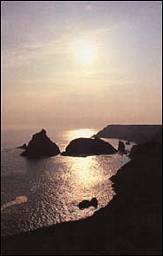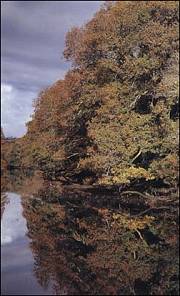 |
The
Lizard Peninsula
The Helford River
The Lizard Peninsula is, quite simply, unique. Standing alone in a very real sense, the Peninsula is physically separate from the main backbone of Cornwall and the saying "off the beaten track" is an appropriate one for this largely undiscovered treasure. Designated an Area of Outstanding Natural Beauty, much of the coastline fails under the stewardship of the National Trust. The South West Coast Path - winding its way around the Peninsula - provides exceptionally beautiful walks for ramblers of all ages and ability.
This is a place of contrasts. The dramatic cliffs around Kynance, Mullion and Lizard Point present a rugged face to the elements while, to the east, the softer, greener landscape of the Helford River shows the visitor an entirely different side to this enchanted area.
As mainland England's most southerly point, the Lizard Peninsula enjoys the full benefit of the Gulf Stream - making the weather perfect for out of season breaks. The effect of this climate on local flora is outstanding, sub-tropical vegetation providing a profusion of colour for most of the year.
The Lizard is a naturalist's delight, Spring arrives early and cliff walks present a wide range of both rare and common flowers. Hedgerows are full of foxgloves, primroses, violets and wild garlic. Seals, basking sharks and dolphins are commonly seen and the rock pools are full of fascination. The area is perhaps most rewarding for the ornithologist as there are many bird species - resident summer visitors and passerines. Although most people arrive in Summer, many others now follow the birdwatchers in Autumn - when Indian Summers are common - or in early Spring, when a large number of migrant birds can be spotted.
 Lizard
Point itself has a brooding and awe-inspiring beauty, its lighthouse flashing
out a 29 mile beam to guide mariners navigating the English Channel. In
Summer, the cliffs and seas around the Lizard appear benign and friendly,
but in Winter - with gales lashing the coast - one is reminded of the
awesome power of the sea and of the many shipwrecks and tales of lifesaving
heroism which are legend around these waters.
Lizard
Point itself has a brooding and awe-inspiring beauty, its lighthouse flashing
out a 29 mile beam to guide mariners navigating the English Channel. In
Summer, the cliffs and seas around the Lizard appear benign and friendly,
but in Winter - with gales lashing the coast - one is reminded of the
awesome power of the sea and of the many shipwrecks and tales of lifesaving
heroism which are legend around these waters.
To the east of Lizard Village lie further treasures - pretty hamlets such as St. Martin, Cury, Porthoustock, Porthallow and Ruan Minor await exploration and there are ideal family beaches such as Kennack Sands - where Daphne du Maurier learned to swim as a child.
Echoes of a proud fishing industry remain in Cadgwith and Coverack, where a small fleet of local fishing boats still survives. These are archetypal Cornish fishing villages; a cluster of nets, lobster pots and boats lying together within the protective granite arms of the harbour. There are cosy, whitewashed cottages, a maze of backstreets and lanes and a pub or two, where locals recount tales of the sea. Visit Cadgwith on a gig-racing day and join in the friendly rivalry as local teams battle it out in brightly coloured craft - or try watersports such as snorkelling, scuba diving or windsurfing at nearby Coverack.
St Keverne is the natural focus for this part of the Peninsula - pubs, restaurants and shops enclose the village square, which comes alive throughout the summer months with band concerts and the annual Ox Roast. Just outside the village, a statue commemorating the 500th anniversary of the 1497 Cornish Rebellion is well worth a visit, or seek out the memorial plaque to the executed leaders of the march, which can be seen on the church wall.
The open plateau of Goonhilly Downs is unique, an extensive heath of international botanical importance. Giant tracking dishes of the British Telecom Satellite Earth Station are visible on the Downs for many miles, creating an almost surreal landscape as they cast long shadows across prehistoric burial barrows, menhirs and standing stones. Surrounded by the technology of tomorrow, one can simply stand here and look back to yesterday and beyond, across a span of some 3000 years.
Mullion is the largest settlement on the Lizard and makes an ideal base from which to explore the rest of the Peninsula. A bustling village centre offers the visitor a range of shopping, places to eat and a local crafts centre, while Mullion Cove itself is a remarkable sight - huge cliffs towering protectively above the pretty working harbour. Within easy reach of Mullion too are the popular sandy beaches of Polurrian, Poldhu and Gunwalloe. Head south from Mullion, along a spectacular section of the coastal footpath, to Kynance Cove - the picture postcard spot that was once the favourite destination of wealthy Victorian "excursionists". As well as golden sands, Kynance is renowned for its huge and dramatic outcrops of serpentine, a dark rock mottled and veined with green, red and white which is unique to the Lizard. One of the oldest rock types in Britain, visitors to the Peninsula can see serpentine being fashioned into collectable souvenirs at one of several serpentine turners' workshops on the Lizard.
The Helford River, immortalised by Daphne du Maurier in her romantic novel Frenchman's Creek, presents an entirely different landscape from the rest of the Lizard Peninsula, and indeed from the rest of Cornwall. This is a lush wooded river world of inlets and creeks, of sub-tropical gardens and riverside villages, of oyster beds and sailing ships and people messing about in boats'.
Much of the area is best discovered on foot. Explore by car and the river, glimpsed through a curtain of trees, will stay tantalisingly out of reach. Peaceful villages stowaway in the folds of this landscape: Helford Village with its riverside setting; the ancient churches of Mawgan, Manaccan and St. Anthony; and Gweek, home to the National Seal Sanctuary.
From the picturesque villages of Constantine and Mawgan you can meander down gladed footpaths to creeks such as Port Navas or Polwherveral, with their oyster beds and yacht moorings. Strike north from Mawnan Smith to the lush gardens of Penjerrick, or south for the exotic gardens sloping gently down to the river at Glendurgan and Trebah. Durgan, a tiny hamlet, is typical of the riverside scenery in these parts. Busy yourself doing absolutely nothing; relax, unwind and watch the river - and the world - float by.
 The
Helford River
The
Helford River